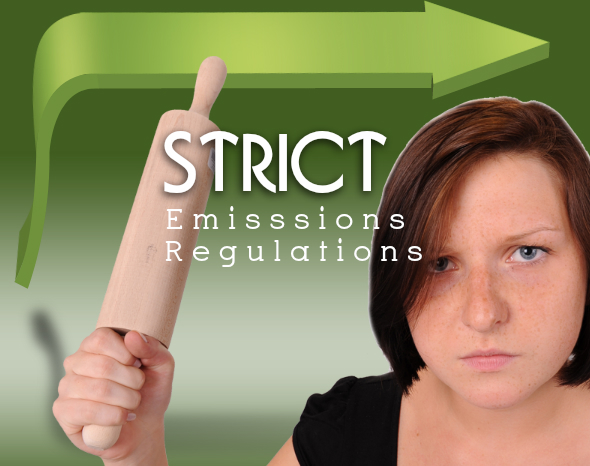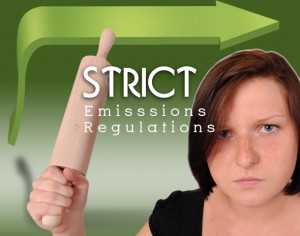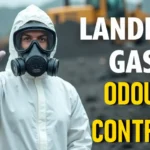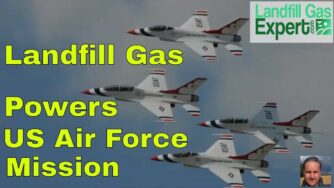The waste management industry is required to control UK landfill gas emissions to a high standard. The Environment Agency (EA) ensures that all licensed (closed) or permitted landfill sites which contain landfill gas are regulated to ensure that emissions are kept to a minimum. This is enforced either under the pollution prevention and control (PPC) regime, or the earlier waste management licensing system which continues to apply to older sites.
(Note: This article is an updated version of an article originally published in November 2012.)
In addition to measures to now largely completed on landfills throughout the United Kingdom to reduce methane emissions, operators will now have to tackle long neglected issues related to trace landfill gas compounds and combustion by-products.
The process, which commenced in line with increasing public awareness of air quality issues around landfills, is also now very popular for the reduction in the greenhouse gas effect achieved by these measures.
What is surprising, however, is the continued absence of a well organised programme to tackle closed landfill sites which predate licensing laws, which remain significant in terms of emissions. In fact most owners of these old sites are local authorities, and these are becoming increasingly aware of the need for emissions control, so most old sites in public ownership do now have landfill gas flaring provisions.
Today, operational landfill sites taking biodegradable waste are routinely fitted with active gas extraction and migration controls are built into the lining designs. Landfill gas generation is usually a very profitable activity in the UK with a number of government incentives available to the operators, to encourage renewable energy generation, and a readiness from the grid operators to accept the electricity into their systems.
As a result ever increasing quantities of landfill gas is being burnt in power generation plants.
How Many Landfill Sites in England Have Landfill Gas Control Systems?
The table below shows just how many operational and closed landfills in the UK have landfill gas extraction and flaring facilities installed to minimise greenhouse gas emissions:
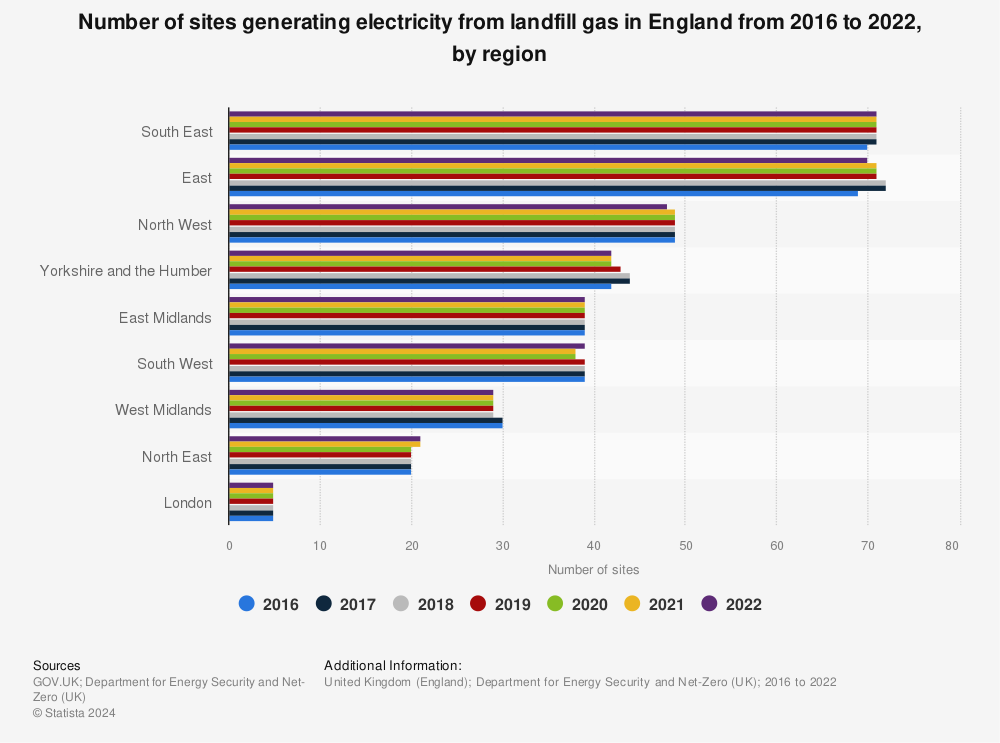
Find more statistics at Statista
The advances have helped to tackle some of the hazards of landfill gas, such as explosion risks by ensuring that the gas is pumped out under suction and thus is unable to migrate, and have also significantly reduced the industry's contribution to greenhouse gas emissions. However, the process has also created a new set of lesser but still worrying environmental problems – in the shape of emissions from flares and engines.
UK Landfill Gas Emissions from Flares and Gas Engines
These emissions were unregulated in the UK until 2003 when new regulations were implemented and the discharges are now monitored to flare type.
The landfill research community – with funding from both the Environment Agency and operators – has made big strides in characterising the range of emissions from typical equipment and standards have now been agreed and set.
In 2003 Environment Agency officials put the proportion of open to enclosed flares at around 50:50. However, since that time operators and owners have invested in enclosed emissions compliant flares in all but the oldest sites which predate the requirements for licensing, and the ratio is now heavily in favour of compliant installations.
Efficiency of UK Landfill Gas Collection
But, how effectively is landfill gas is being collected?
The Agency's local area regulation offices make regular visits to all currently licensed and sites which hold permits. But the Agency published no data at the national level to say how many sites are fitted with flares or gas utilisation equipment until after 2012. Data for England is now published (2020 update).
However, how much information the Agency has for landfill sites that closed before 1994, is doubtful, because these sites were never within the scope of the waste licensing regime.
UK Landfill Gas Emissions Since the EU Landfill Directive
The EU Landfill Directive requires that landfill gas be collected from all sites receiving biodegradable waste, and that this gas must be treated. Landfill Operators of all open permitted landfill sites also must comply with the principals of Best Available Techniques (BAT) as required by the PPC Regulations.
Put simply – If the gas cannot be used to produce energy, it must be flared.
Importantly, the Directive also stipulates that the collection, treatment and use of landfill gas must be carried out in a manner “which minimises damage to or deterioration of the environment and risk to human health.”
Regular EA inspections take place, which would identify non-compliance at any landfill. But, the most likely driver which is ensuring that the extracted landfill gas in the UK is being utilised to make electricity, is the profit motive. LFG utilisation in the UK is a profitable business and has been for at least the last 20 years (written in 2020).
Conclusion
The Agency has now largely completed the huge task in bringing the landfill sector into the PPC permitting regime which was will be complete by the middle of 2007, and will by then have been undertaken over a four year period which commenced in 2003.
Large numbers of LFG utilisation gas engines are in use on UK landfills, and have been for more than 15 years.
The question mark is how many closed landfills, including old landfills pre-1994 which are not regulated under any regulations, as long as they do not pollute, are not collecting landfill gas?
Gas flows will not be high now for the old closed landfills pre-1994, but they will continue to emit low calorie LFG for many years. For reasons of this longevity the amount emitted adds up to a significant amount due to the long timescales of low-calorie LFG emissions.
The UK compliance with all UK landfill gas emissions for post 1994 landfills is thought to be good, by this author.
Best Practices in Odour Control Using Landfill Gas Extraction Systems
Landfill gas extraction systems effectively control odour by capturing and treating gases from decomposing waste. Proper system design, strategic well placement, and regular maintenance are crucial for minimizing fugitive emissions and odour complaints, with reductions of up to 85% achievable when these best practices are followed…
UK Landfill Gas Emissions Control
The Stringent EA Controls, Which Limit UK Landfill Gas Emissions to Minimise the Emission of Carbon Dioxide thought to be a Significant Cause of Climate Change The UK waste management industry is required to control landfill gas emissions to a high standard. The Environment Agency (EA) is responsible for regulating landfills and ensuring that all […]
Landfill Site Permit Applications – The Role of Risk Assessments in Emissions Control
Landfill site emissions risk assessments are a mandatory requirement for environmental permit applications (previously known as Landfill Site PPC Applications). They identify possible hazards to the environment and public health from landfill gas and leachate. The procedure calls for a thorough examination of landfill emissions, including assessments of the effects on the air, groundwater, and surface […]
Landfill Gas Pin Wells: A Low-Cost, High-Impact LFG Extraction Option
Discover the advantages of landfill gas pin wells, a cost-effective solution for efficient LFG extraction. Easier installation, lower costs, and increased gas capture make them ideal for sustainability. Learn how pin wells transform waste into energy, reducing emissions and supporting renewable projects across waste management facilities…

